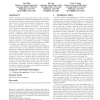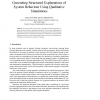695 search results - page 18 / 139 » The structure of intrinsic complexity of learning |
WIRN
2005
Springer
14 years 1 months ago
2005
Springer
Recursive neural networks are a powerful tool for processing structured data. According to the recursive learning paradigm, the input information consists of directed positional ac...
Publication
We generalise the problem of inverse reinforcement learning to multiple tasks, from multiple demonstrations. Each one may represent one expert trying to solve a different task, or ...
KDD
2010
ACM
13 years 11 months ago
2010
ACM
Feature selection is an important task in order to achieve better generalizability in high dimensional learning, and structure learning of Markov random fields (MRFs) can automat...
AIED
2005
Springer
14 years 1 months ago
2005
Springer
This paper presents an approach to generate structured explanations of system behaviour based on qualitative simulations. This has been implemented in WiziGarp, a domain-independen...
ISBI
2008
IEEE
14 years 1 months ago
2008
IEEE
A stratification and manifold learning approach for analyzing High Angular Resolution Diffusion Imaging (HARDI) data is introduced in this paper. HARDI data provides highdimensio...


